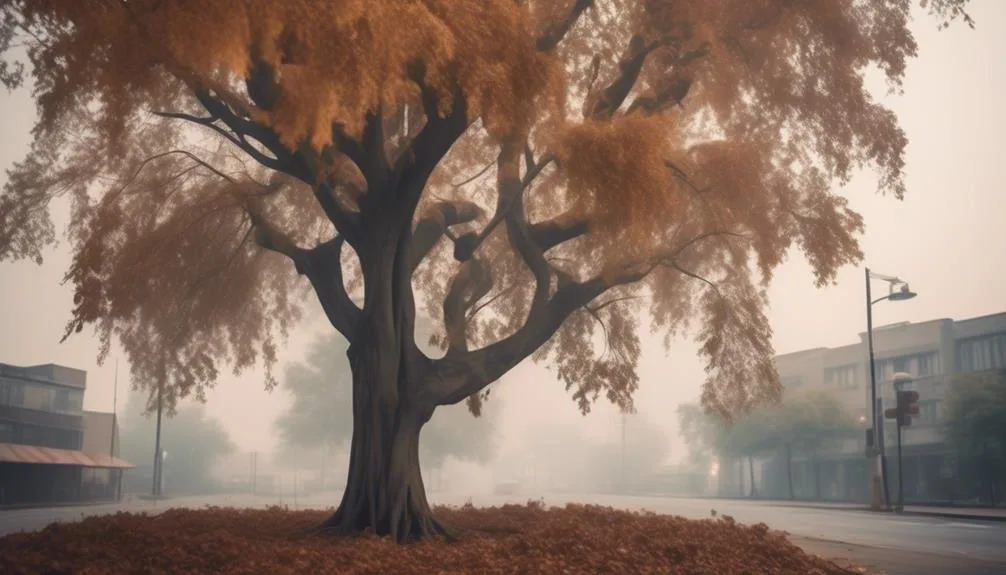Do hickory trees stand strong against air pollution?
The impact of pollution on these trees has piqued interest.
Discover the ways hickory trees adapt to pollution.
Gain insights into their resilience and how to protect them.
Tolerance to Air Pollution
If you're curious about how hickory trees manage to tolerate air pollution, their remarkable ability to withstand environmental stressors is a fascinating subject to explore.
Genetic resilience plays a crucial role in enabling hickory trees to thrive despite the presence of air pollutants. These trees possess a unique genetic makeup that equips them with the tools needed to combat environmental stressors.
Their genetic resilience allows them to adapt and survive in polluted environments, showcasing their remarkable ability to overcome adversity. Despite the challenges posed by air pollution, hickory trees continue to stand tall, thanks to their genetic resilience.
Understanding how hickory trees have evolved to cope with environmental stressors not only sheds light on their remarkable adaptability but also provides valuable insights for conservation efforts in polluted areas.
Effects of Air Pollution on Hickory Trees
Hickory trees, resilient as they may be, are not immune to the detrimental effects of air pollution. Air pollution can lead to leaf discoloration, stunted growth, and overall decline in tree health. The leaves of hickory trees may exhibit signs of yellowing or browning, indicating stress caused by air pollutants such as ozone and sulfur dioxide. Additionally, pollutants can alter soil composition, affecting the tree's ability to uptake essential nutrients and water. This can lead to reduced vitality and increased susceptibility to pests and diseases. Below is a table summarizing the effects of air pollution on hickory trees:
| Effects of Air Pollution on Hickory Trees |
|---|
| Leaf Discoloration |
| Stunted Growth |
| Altered Soil Composition |
| Increased Vulnerability to Stressors |
Adaptations of Hickory Trees to Air Pollution
Despite the challenges posed by air pollution, hickory trees have developed remarkable adaptations to mitigate its adverse effects and ensure their survival. These resilient trees have evolved mechanisms at the physiological level to combat the impact of air pollution.
One such adaptation is their ability to close the stomata, tiny openings on the leaves, when pollution levels are high. This helps minimize the intake of pollutants, thus reducing potential damage.
Additionally, hickory trees have enhanced antioxidant systems that enable them to neutralize the harmful effects of pollutants, such as ozone and nitrogen oxides.
Furthermore, they've developed thicker cuticles on their leaves, acting as a protective barrier against pollutants.
These adaptations highlight the remarkable ability of hickory trees to adjust to challenging environmental conditions, showcasing their resilience in the face of air pollution.
Air Pollution Impact on Hickory Tree Growth
With their remarkable adaptations to combat the impact of air pollution, hickory trees face a significant challenge in maintaining their growth and vitality in polluted environments. The detrimental effects of air pollution on hickory tree growth have far-reaching consequences, not only for the trees themselves but also for the wildlife and soil health in their surrounding ecosystems.
Consider the following:
- Impact on Wildlife:
- Decreased hickory tree growth limits the availability of food and habitat for wildlife, disrupting the delicate balance of ecosystems.
- Wildlife species that rely on hickory trees for food and shelter may face population declines, impacting biodiversity and overall ecosystem health.
- Soil Health:
- Air pollution can lead to soil acidification, which directly affects the nutrient uptake and overall health of hickory trees.
- Reduced hickory tree growth can result in decreased organic matter input into the soil, impacting soil structure and fertility.
The impact of air pollution on hickory tree growth extends beyond the trees themselves, affecting the intricate web of life within their ecosystems.
Measures to Protect Hickory Trees From Air Pollution
To safeguard hickory trees from the detrimental effects of air pollution, implementing strategic measures is crucial for their continued health and resilience in polluted environments. Protective measures such as environmental regulations and targeted interventions can significantly mitigate the impact of air pollution on hickory trees. These measures are essential for preserving the ecological balance and biodiversity of hickory tree populations. By adhering to environmental regulations and implementing specific protective measures, the adverse effects of air pollution on hickory trees can be minimized, ensuring their sustained growth and vitality. Below is a table outlining some protective measures and their potential benefits:
| Protective Measures | Potential Benefits |
|---|---|
| Emission reduction | Decreased pollutant exposure |
| Green belt establishment | Improved air quality |
| Tree maintenance | Enhanced tree resilience |
| Public awareness | Support for environmental action |
Conclusion
In light of their moderate tolerance to air pollution, it's crucial to safeguard hickory trees from its detrimental effects to ensure their continued vitality. Understanding the impact of pollution and implementing protective measures will help preserve these resilient trees for future generations.
How can we collectively contribute to the protection of hickory trees in the face of environmental challenges?
Mark Hoffman is a dedicated arborist and tree care specialist with over a decade of experience. His love for trees began when he visited Yosemite National Park as a teenager and was awestruck by the giant sequoias. Mark pursued his passion by studying forestry at Michigan Technological University, where he earned a Bachelor of Science degree.
Since then, he has worked tirelessly in the field of arboriculture, helping to preserve and protect trees in his community. His expertise and dedication have made him a respected leader in the industry and a valuable resource for anyone seeking advice on tree care.
